#1810s.
Explore tagged Tumblr posts
Text
sc 𝑓𝑡. @vitalphenomena

❛ Isn't it time for your milk and arsenic, darling? ❜
#High Society ( 1956 )#for dolokhov.. obvi#1810s.#vitalphenomena#* filed under — ( verse ) ( histoire )#* filed under — ( verse ) ( interactions ) ( histoire )
23 notes
·
View notes
Text










Another selection of some of the better names I've come across in Regency era newspapers recently.
#names#history#1790s#1800s#1810s#regency#regency era#yesterday I came across a 'Pleasant Cowmeadow' which I really wanted to include but it's handwritten in not the most legible handwriting
16K notes
·
View notes
Text




Court train, First French Empire
From Kerry Taylor Auctions
2K notes
·
View notes
Text




Evening dress, c. 1810. Machine-made silk net, embroidered with chenille thread; with silk ribbon; hand sewn.
Dress of red silk machine-made net, with high waist, low neck and short, slightly gathered sleeves. The bodice fastens at the centre back with a narrow red silk ribbon at the waistline. The neckband and sleeves and a v-shaped insertion in the bodice front are embroidered with a design of rosebud garlands worked in pink, red and green chenille. This embroidery is repeated at the hem, with a wider trail of roses and rosebuds. It apparently had a red under-dress.
2K notes
·
View notes
Text


The Trans Court Suit
This was my big project I made over the summer! I am beyond proud of and happy with the coat.
The first initial project I wanted for this was a pink waistcoat. I grew up liking pink and most of my stuff was, but that (along with growing up in a hot pink room) made me start to resent pink a lot especially as a teenager. (I think a lot of trans guys have similar stories.) But of course pink was very popular for men throughout a lot of European fashion history. So in many ways this was a self healing project for me, at least in that regard. Which I think was a success!
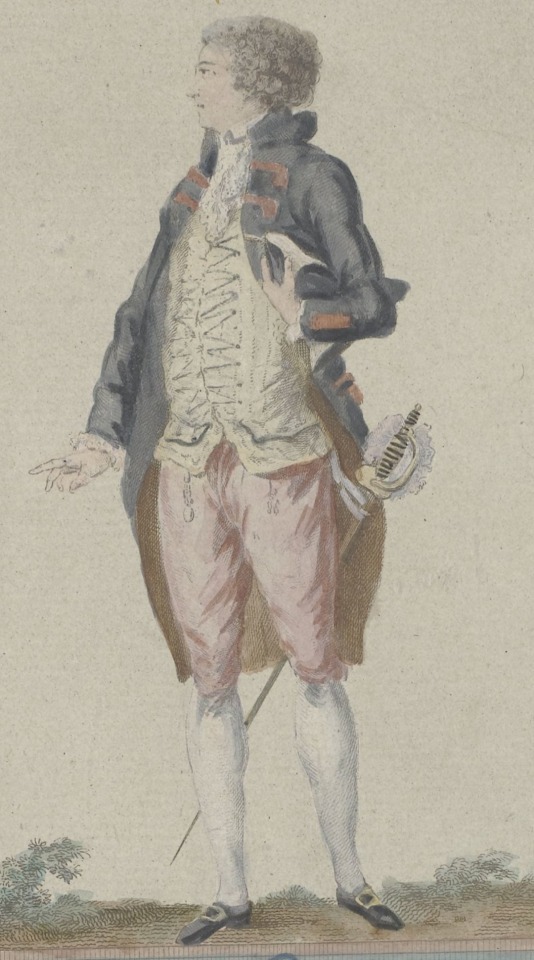



I actually found the first two portraits after I started working on the outfit, they looked perfect! The first especially is super close to my hair.
The silks for the coat as well as the linen interfacings were second hand or scraps in my stash. The cotton sateen was from Burnley and Trowbridge. This is the first project I fully drafted myself. The waistcoat and breeches were made from an 1820s manual and the coat was primarily taken from Period Patterns by Doris Edison, using also Agreeable Tyrant for interfacings and The Taylor's Complete Guide (for shape reference).
This is also the most hand sewing I’ve done for an outfit. Both of the fronts of the coat and waistcoat are completely by hand. Most of the coat is by hand with machine for structural/backstitches, mostly the seams but not the edges. In total there are 22 buttons.
I made the waistcoat straight across for two reasons A. So I can wear it with my other stuff B. I didn’t have any more trim, that was it. I’ll probably make a more 18th century style waistcoat out of white for this (at some point).
The breeches ended up being too small for my thighs so I started getting frustrated with the fit and rushed them by the end so I could move on. (I accidentally sewed the buttonholes on the wrong side).
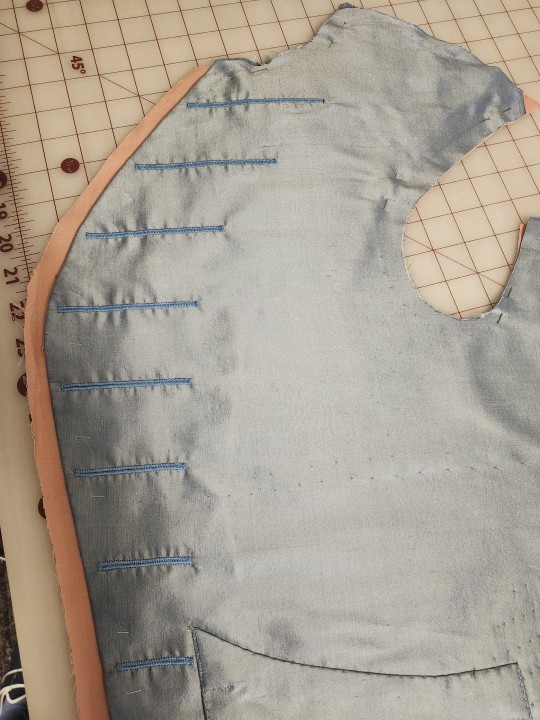


2K notes
·
View notes
Text


Evening Dress
1812-1815
The Victoria & Albert Museum
1K notes
·
View notes
Text

❛ I'm leaving. ❜ Now.
Leave room for the Holy Spirit; he steps in, she goes back. Him on his pride tipped jaw and her own her pride bellowed heel. Proximity allows a theater's exit. She gold-swipes him by her half-undone-hair as she walks away.
❛ God keep you! ❜
A sweetheart's insult.

GO ON, THEN. Stuff him with silk. Gag him, silence him. He would love that, I think.
He steps closer, juts out his chin, parts his lips. GO ON, THEN.
"And you have yours, princess."
#1810s.#vitalphenomena#* filed under — ( verse ) ( histoire )#* filed under — ( verse ) ( interactions ) ( histoire )
14 notes
·
View notes
Text

1810s-1820s Attr. to Louis Hersent - Presumable portrait of Jenny Hoche, Countess des Roys
(Pierre Bergé & Associés Auction House)
680 notes
·
View notes
Text


Dress
c. 1818-1822
English
Kent State University Museum
#1810s#1820s#regency fashion#regency#romantic era#fashion history#historical fashion#history of fashion#dress history#frostedmagnolias
695 notes
·
View notes
Text
Look... I fully respect the Bridgerton costume designers' decision to just abandon historical accuracy and do their own thing.
But I will never, EVER forgive them for not using period accurate British court fashion in the one setting ridiculous enough that they might have actually pulled it off.

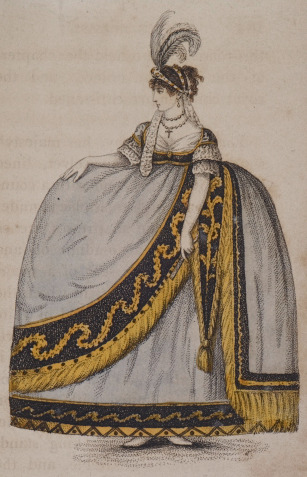
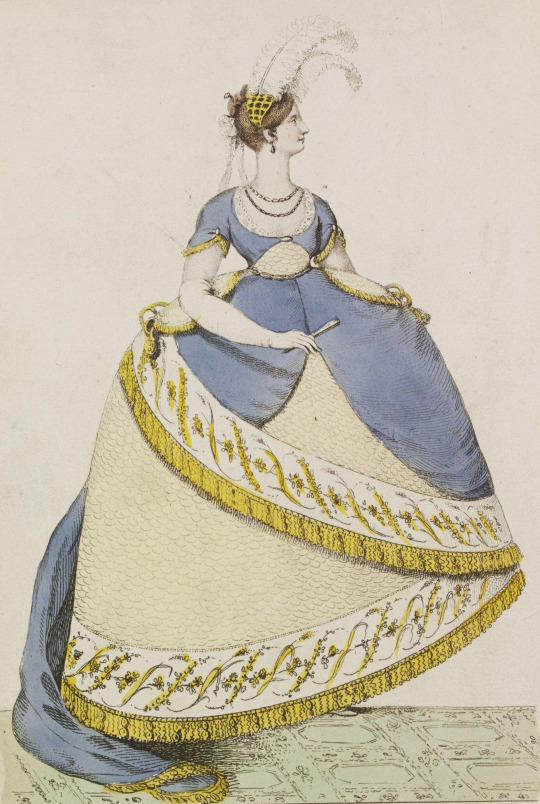


#we could have had it ALLLLLLLLLL#and yes I realize this was probably a budget issue#but why can't we have ridiculous historically accurate things you cowards#bridgerton#regency#regency era#1800s#1810s#fashion history
1K notes
·
View notes
Text



Cotton dress, 1812-18
From the London Museum
#dress#fashion#fashion history#1812#1818#1810s#1800s#19th century#regency#georgian#(the style of the dress feels earlier than 1812 to me?? but maybe it was just made for someone not on top of changing fashion trends?)
670 notes
·
View notes
Text

~ Barbara Krafft, Portrait of Anna Maria Lergetporer (1811) (detail)
via historicalbeauty
#barbara krafft#painting#fine art#art history#art#old paintings#painting detail#art detail#austrian art#austrian artist#austrian painting#early 19th century#19th century art#19th century painting#portrait#portraiture#portrait painting#women in art#fashion history#historical fashion#history of fashion#regency fashion#regency painting#regency art#regency#regency aesthetic#1810s#1810s fashion#1810s art#1811
388 notes
·
View notes
Text
A Guide to Historically Accurate Regency-Era Names

I recently received a message from a historical romance writer asking if I knew any good resources for finding historically accurate Regency-era names for their characters.
Not knowing any off the top of my head, I dug around online a bit and found there really isn’t much out there. The vast majority of search results were Buzzfeed-style listicles which range from accurate-adjacent to really, really, really bad.
I did find a few blog posts with fairly decent name lists, but noticed that even these have very little indication as to each name’s relative popularity as those statistical breakdowns really don't exist.
I began writing up a response with this information, but then I (being a research addict who was currently snowed in after a blizzard) thought hey - if there aren’t any good resources out there why not make one myself?
As I lacked any compiled data to work from, I had to do my own data wrangling on this project. Due to this fact, I limited the scope to what I thought would be the most useful for writers who focus on this era, namely - people of a marriageable age living in the wealthiest areas of London.
So with this in mind - I went through period records and compiled the names of 25,000 couples who were married in the City of Westminster (which includes Mayfair, St. James and Hyde Park) between 1804 to 1821.
So let’s see what all that data tells us…
To begin - I think it’s hard for us in the modern world with our wide and varied abundance of first names to conceive of just how POPULAR popular names of the past were.
If you were to take a modern sample of 25-year-old (born in 1998) American women, the most common name would be Emily with 1.35% of the total population. If you were to add the next four most popular names (Hannah, Samantha, Sarah and Ashley) these top five names would bring you to 5.5% of the total population. (source: Social Security Administration)
If you were to do the same survey in Regency London - the most common name would be Mary with 19.2% of the population. Add the next four most popular names (Elizabeth, Ann, Sarah and Jane) and with just 5 names you would have covered 62% of all women.
To hit 62% of the population in the modern survey it would take the top 400 names.
The top five Regency men’s names (John, William, Thomas, James and George) have nearly identical statistics as the women’s names.
I struggled for the better part of a week with how to present my findings, as a big list in alphabetical order really fails to get across the popularity factor and also isn’t the most tumblr-compatible format. And then my YouTube homepage recommended a random video of someone ranking all the books they’d read last year - and so I present…
The Regency Name Popularity Tier List
The Tiers
S+ - 10% of the population or greater. There is no modern equivalent to this level of popularity. 52% of the population had one of these 7 names.
S - 2-10%. There is still no modern equivalent to this level of popularity. Names in this percentage range in the past have included Mary and William in the 1880s and Jennifer in the late 1970s (topped out at 4%).
A - 1-2%. The top five modern names usually fall in this range. Kids with these names would probably include their last initial in class to avoid confusion. (1998 examples: Emily, Sarah, Ashley, Michael, Christopher, Brandon.)
B - .3-1%. Very common names. Would fall in the top 50 modern names. You would most likely know at least 1 person with these names. (1998 examples: Jessica, Megan, Allison, Justin, Ryan, Eric)
C - .17-.3%. Common names. Would fall in the modern top 100. You would probably know someone with these names, or at least know of them. (1998 examples: Chloe, Grace, Vanessa, Sean, Spencer, Seth)
D - .06-.17%. Less common names. In the modern top 250. You may not personally know someone with these names, but you’re aware of them. (1998 examples: Faith, Cassidy, Summer, Griffin, Dustin, Colby)
E - .02-.06%. Uncommon names. You’re aware these are names, but they are not common. Unusual enough they may be remarked upon. (1998 examples: Calista, Skye, Precious, Fabian, Justice, Lorenzo)
F - .01-.02%. Rare names. You may have heard of these names, but you probably don’t know anyone with one. Extremely unusual, and would likely be remarked upon. (1998 examples: Emerald, Lourdes, Serenity, Dario, Tavian, Adonis)
G - Very rare names. There are only a handful of people with these names in the entire country. You’ve never met anyone with this name.
H - Virtually non-existent. Names that theoretically could have existed in the Regency period (their original source pre-dates the early 19th century) but I found fewer than five (and often no) period examples of them being used in Regency England. (Example names taken from romance novels and online Regency name lists.)
Just to once again reinforce how POPULAR popular names were before we get to the tier lists - statistically, in a ballroom of 100 people in Regency London: 80 would have names from tiers S+/S. An additional 15 people would have names from tiers A/B and C. 4 of the remaining 5 would have names from D/E. Only one would have a name from below tier E.
Women's Names
S+ Mary, Elizabeth, Ann, Sarah
S - Jane, Mary Ann+, Hannah, Susannah, Margaret, Catherine, Martha, Charlotte, Maria
A - Frances, Harriet, Sophia, Eleanor, Rebecca
B - Alice, Amelia, Bridget~, Caroline, Eliza, Esther, Isabella, Louisa, Lucy, Lydia, Phoebe, Rachel, Susan
C - Ellen, Fanny*, Grace, Henrietta, Hester, Jemima, Matilda, Priscilla
D - Abigail, Agnes, Amy, Augusta, Barbara, Betsy*, Betty*, Cecilia, Christiana, Clarissa, Deborah, Diana, Dinah, Dorothy, Emily, Emma, Georgiana, Helen, Janet^, Joanna, Johanna, Judith, Julia, Kezia, Kitty*, Letitia, Nancy*, Ruth, Winifred>
E - Arabella, Celia, Charity, Clara, Cordelia, Dorcas, Eve, Georgina, Honor, Honora, Jennet^, Jessie*^, Joan, Joyce, Juliana, Juliet, Lavinia, Leah, Margery, Marian, Marianne, Marie, Mercy, Miriam, Naomi, Patience, Penelope, Philadelphia, Phillis, Prudence, Rhoda, Rosanna, Rose, Rosetta, Rosina, Sabina, Selina, Sylvia, Theodosia, Theresa
F - (selected) Alicia, Bethia, Euphemia, Frederica, Helena, Leonora, Mariana, Millicent, Mirah, Olivia, Philippa, Rosamund, Sybella, Tabitha, Temperance, Theophila, Thomasin, Tryphena, Ursula, Virtue, Wilhelmina
G - (selected) Adelaide, Alethia, Angelina, Cassandra, Cherry, Constance, Delilah, Dorinda, Drusilla, Eva, Happy, Jessica, Josephine, Laura, Minerva, Octavia, Parthenia, Theodora, Violet, Zipporah
H - Alberta, Alexandra, Amber, Ashley, Calliope, Calpurnia, Chloe, Cressida, Cynthia, Daisy, Daphne, Elaine, Eloise, Estella, Lilian, Lilias, Francesca, Gabriella, Genevieve, Gwendoline, Hermione, Hyacinth, Inez, Iris, Kathleen, Madeline, Maude, Melody, Portia, Seabright, Seraphina, Sienna, Verity
Men's Names
S+ John, William, Thomas
S - James, George, Joseph, Richard, Robert, Charles, Henry, Edward, Samuel
A - Benjamin, (Mother’s/Grandmother’s maiden name used as first name)#
B - Alexander^, Andrew, Daniel, David>, Edmund, Francis, Frederick, Isaac, Matthew, Michael, Patrick~, Peter, Philip, Stephen, Timothy
C - Abraham, Anthony, Christopher, Hugh>, Jeremiah, Jonathan, Nathaniel, Walter
D - Adam, Arthur, Bartholomew, Cornelius, Dennis, Evan>, Jacob, Job, Josiah, Joshua, Lawrence, Lewis, Luke, Mark, Martin, Moses, Nicholas, Owen>, Paul, Ralph, Simon
E - Aaron, Alfred, Allen, Ambrose, Amos, Archibald, Augustin, Augustus, Barnard, Barney, Bernard, Bryan, Caleb, Christian, Clement, Colin, Duncan^, Ebenezer, Edwin, Emanuel, Felix, Gabriel, Gerard, Gilbert, Giles, Griffith, Harry*, Herbert, Humphrey, Israel, Jabez, Jesse, Joel, Jonas, Lancelot, Matthias, Maurice, Miles, Oliver, Rees, Reuben, Roger, Rowland, Solomon, Theophilus, Valentine, Zachariah
F - (selected) Abel, Barnabus, Benedict, Connor, Elijah, Ernest, Gideon, Godfrey, Gregory, Hector, Horace, Horatio, Isaiah, Jasper, Levi, Marmaduke, Noah, Percival, Shadrach, Vincent
G - (selected) Albion, Darius, Christmas, Cleophas, Enoch, Ethelbert, Gavin, Griffin, Hercules, Hugo, Innocent, Justin, Maximilian, Methuselah, Peregrine, Phineas, Roland, Sebastian, Sylvester, Theodore, Titus, Zephaniah
H - Albinus, Americus, Cassian, Dominic, Eric, Milo, Rollo, Trevor, Tristan, Waldo, Xavier
# Men were sometimes given a family surname (most often their mother's or grandmother's maiden name) as their first name - the most famous example of this being Fitzwilliam Darcy. If you were to combine all surname-based first names as a single 'name' this is where the practice would rank.
*Rank as a given name, not a nickname
+If you count Mary Ann as a separate name from Mary - Mary would remain in S+ even without the Mary Anns included
~Primarily used by people of Irish descent
^Primarily used by people of Scottish descent
>Primarily used by people of Welsh descent
I was going to continue on and write about why Regency-era first names were so uniform, discuss historically accurate surnames, nicknames, and include a little guide to finding 'unique' names that are still historically accurate - but this post is already very, very long, so that will have to wait for a later date.
If anyone has any questions/comments/clarifications in the meantime feel free to message me.
Methodology notes: All data is from marriage records covering six parishes in the City of Westminster between 1804 and 1821. The total sample size was 50,950 individuals.
I chose marriage records rather than births/baptisms as I wanted to focus on individuals who were adults during the Regency era rather than newborns. I think many people make the mistake when researching historical names by using baby name data for the year their story takes place rather than 20 to 30 years prior, and I wanted to avoid that. If you are writing a story that takes place in 1930 you don’t want to research the top names for 1930, you need to be looking at 1910 or earlier if you are naming adult characters.
I combined (for my own sanity) names that are pronounced identically but have minor spelling differences: i.e. the data for Catherine also includes Catharines and Katherines, Susannah includes Susannas, Phoebe includes Phebes, etc.
The compound 'Mother's/Grandmother's maiden name used as first name' designation is an educated guesstimate based on what I recognized as known surnames, as I do not hate myself enough to go through 25,000+ individuals and confirm their mother's maiden names. So if the tally includes any individuals who just happened to be named Fitzroy/Hastings/Townsend/etc. because their parents liked the sound of it and not due to any familial relations - my bad.
I did a small comparative survey of 5,000 individuals in several rural communities in Rutland and Staffordshire (chosen because they had the cleanest data I could find and I was lazy) to see if there were any significant differences between urban and rural naming practices and found the results to be very similar. The most noticeable difference I observed was that the S+ tier names were even MORE popular in rural areas than in London. In Rutland between 1810 and 1820 Elizabeths comprised 21.4% of all brides vs. 15.3% in the London survey. All other S+ names also saw increases of between 1% and 6%. I also observed that the rural communities I surveyed saw a small, but noticeable and fairly consistent, increase in the use of names with Biblical origins.
Sources of the records I used for my survey:
Ancestry.com. England & Wales Marriages, 1538-1988 [database on-line].
Ancestry.com. Westminster, London, England, Church of England Marriages and Banns, 1754-1935 [database on-line].
#history#regency#1800s#1810s#names#london#writing resources#regency romance#jane austen#bridgerton#bridgerton would be an exponentially better show if daphne's name was dorcas#behold - the reason i haven't posted in three weeks
12K notes
·
View notes
Text
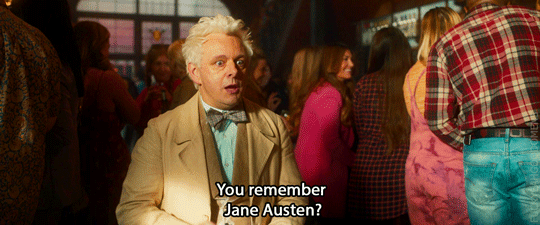
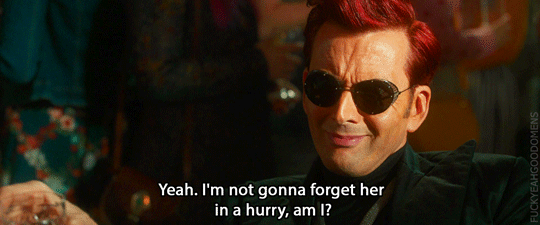
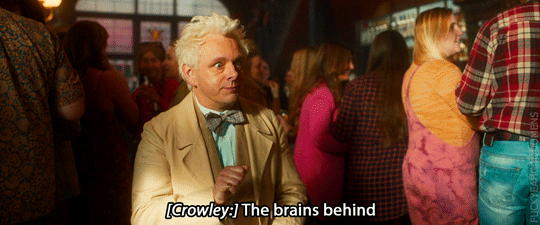



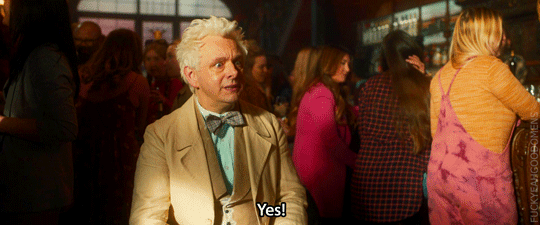




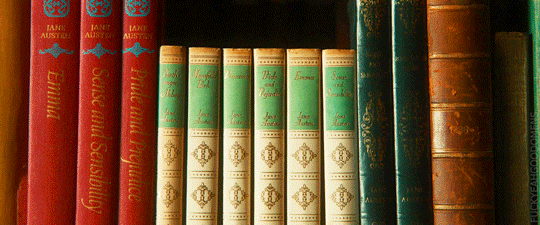

Aziraphale: You remember Jane Austen?
Crowley: Yeah. I'm not gonna forget her in a hurry, am I? The brains behind the 1810 Clerkenwell Diamond Robbery. Brandy smuggler. Master spy. What a piece of work.
Aziraphale: She wrote books.Novels.
Crowley: Jane? Austen?
Aziraphale: Yes!
Crowley: Whoa, bit of a dark horse. Novels, eh?
Aziraphale: Yes. They were very good.
Crowley: Well. No, I'm just surprised, that's all. You think you know someone.
later in Aziraphale's bookshop Crowley sees Jane Austen's books on a shelf and picks the Pride and Prejudice:
Crowley: Jane Austen. Wrote books too. You people, I will never get the hang of you lot.
Bonus:
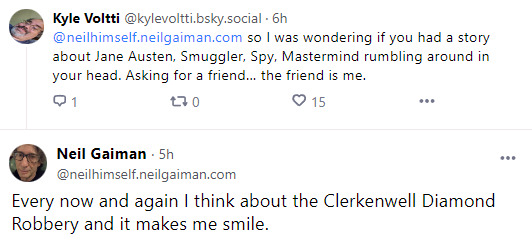
#good omens#goodomensedit#david tennant#michael sheen#crowley#aziraphale#2ep2#2i2i6#2i2i7#jane austen#1810 clerkenwell diamond robbery#ac#dirty donkey#aziraphale's bookshop#aziraphale's shelves#aziraphale's books
2K notes
·
View notes
Text

Jean Bernard (Dutch, 1775–1883), "Sitting Cat", 1819
#Jean Bernard#art#dutch art#drawing#drawings#animals in art#animals#cat#cats#cat drawing#cats in art#19th century art#19th century#1810s#art history#aesthetic#monochrome#black and white#b&w
268 notes
·
View notes
Text

Girl rejects the bad-tasting medicine. Mary and her cat. 1810.
Internet Archive
#children's book#illustration#medicine#illness#sick child#girl#girls#mother and child#nemfrog#1810#19th century
230 notes
·
View notes